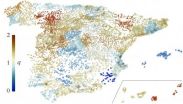(Press-News.org) URBANA – Researchers in the Evolutionary Bioinformatics Laboratory at the University of Illinois in collaboration with German scientists have been using bioinformatics techniques to probe the world of proteins for answers to questions about the origins of life.
Proteins are formed from chains of amino acids and fold into three-dimensional structures that determine their function. According to crop sciences professor Gustavo Caetano-Anollés, very little is known about the evolutionary drivers for this folding.
In collaboration with scientists at the Heidelberg Institute for Theoretical Studies, he has been working at the interface of molecular evolution and molecular dynamics, looking back to when proteins first appeared approximately 3.8 billion years ago to determine changes in folding speed over time.
To do this, they looked at all known protein structures as defined in the Structural Classification of Proteins (SCOP) database and mined their presence in 989 fully sequenced genomes. In a previous study, researchers in Caetano-Anollés's group used SCOP and genomic information to reconstruct phylogenomic trees that describe the history of the protein world. The current research is based on these types of trees.
"They are not the standard trees that people see in phylogenetic analysis," he said. "In phylogenetic analysis, usually the tips of the trees, the leaves, are organisms or microbes. In these, they are entire biological systems."
In contrast, the leaves of these new trees are protein domains, which are compact evolutionary units of structure and function. Proteins are usually complex combinations of several domains.
"We have a world of about 90,000 of these structures, but they seem to be always producing the same designs," he said. Over the last 10 years, he has been part of the effort to map these designs, or folds, because they are determined by the way the protein chains fold on themselves. To date, approximately 1,300 folds have been characterized.
For the current study, the researchers identified protein sequences in the genomes that had the same folding structure as known proteins. They then used bioinformatics techniques to compare them to each other on a time scale to determine when proteins became part of a particular organism. This allowed them to map protein structures and organisms onto a timeline.
Directly calculating the folding speed for all of these proteins would be impossible with today's technology, so the researchers took advantage of the fact that a protein always folds at the same points and used a measure called Size Modified Contact Order (SMCO).
Contact order is the ability of a protein to establish links between segments of the polypeptide chain. When points that are close together on the chain come together, they generally form helical structures; when distant points come together, they form beta strands that interact with each other and form sheets. Contact order measures how many of the connections are local and how many are distant. Experimental studies have shown that it is correlated with folding speed. The measure is normalized (size modified) to take protein length, which affects folding speed, into account.
They saw a peculiar pattern in the results.
"What we see is an hourglass," said Caetano-Anollés. "At the beginning, proteins seem not to be folding so fast. And then, as time progresses, there's a tendency to fold faster and faster. And then it reaches a critical point, and at this point we have a tendency that reverses, that seems to go back again to slow folding." However, the tendency toward higher speed dominates.
This point coincides with what he calls the "Big Bang" in protein evolution. Approximately 1.5 billion years ago, more complex domain structures and multi-domain proteins emerged with the appearance of multicellular organisms. Amino acid chains, which make up proteins, also became shorter at this point in time.
Why does folding speed matter?
"If the protein does not fold, in the vast majority of cases it will not have a function. So folding implies functionality. And speed of folding implies speed of achieving that functionality," he explained. "For a cell, that's very important, because if proteins are very slow folders, there is a time lag to when that function will be accessible to the cell."
Fast folders are also less susceptible to aggregation, or clumping together, so they work faster. Moreover, proteins that fold rapidly are more likely to fold correctly. Protein misfolding has been linked with diseases such as Alzheimer's.
Caetano-Anollés said, however, that this research makes an important contribution to understanding how molecules work. "The complexities of the biological functions of molecules are still poorly understood," he said.
"If we mix the world of molecular dynamics with the world of molecular evolution, we can then determine what aspects of sequences are important for molecular dynamics, and therefore, we can apply them to genetic engineering, synthetic biology, and so on."
###
Untangling life's origins
2013-03-11
ELSE PRESS RELEASES FROM THIS DATE:
The dynamic of Spain's population follows the maximum entropy principle
2013-03-11
A team of Spanish and Argentinean researchers have verified that the distribution of the inhabitants in each Spanish province evolves in accordance with the maximum entropy principle in the field of physics. Therefore, this evolution is predictable. The results have allowed authors to put forward a 'socio-thermodynamic' theory that applies the laws of thermodynamics to collective human behaviour.
Spanish and Argentinean scientists have researched the way in which we as people group together on a large scale as a way of seeing whether there is any law or pattern that explains ...
Ground-level ozone falling faster than model predicted
2013-03-11
There is good news and better news about ground-level ozone in American cities. While dangerous ozone levels have fallen in places that clamp down on emissions from vehicles and industry, a new study from Rice University suggests that a model widely used to predict the impact of remediation efforts has been too conservative.
Particularly in Northeastern cities, ozone levels dropped even beyond what was anticipated by cutting emissions of nitrogen oxides (NOx) from 2002 to 2006. The study published online by the journal Atmospheric Environment suggests the Community Multiscale ...
Can energy drinks improve the physical and mental performance of cyclists?
2013-03-11
New Rochelle, NY, March 11, 2013–Consumption of energy drinks containing caffeine may have beneficial effects on exercise but probably not for mental function. The effects of pre-exercise caffeine consumption by trained cyclists on racing times and cognitive performance were measured and are reported in Journal of Caffeine Research, a peer-reviewed journal from Mary Ann Liebert, Inc., publishers. The article is available free on the Journal of Caffeine Research website at http://www.liebertpub.com/jcr.
Race performance improved for all study participants after consuming ...
Common MS drugs taken together do not reduce relapse risk
2013-03-11
A recent clinical trial found that interferonβ-1a (INF) and glatiramer acetate (GA), two of the most commonly prescribed drugs for multiple sclerosis (MS), provide no additional clinical benefit when taken together. While findings published today in Annals of Neurology, a journal of the American Neurological Association and Child Neurology Society, suggest that taking both INF and GA together was not superior to GA monotherapy in reducing relapse risk; the combination therapy does appear to reduce new lesion activity and total lesion volume.
The National Institute ...
The closest star system found in a century
2013-03-11
A pair of newly discovered stars is the third-closest star system to the Sun, according to a paper that will be published in Astrophysical Journal Letters. The duo is the closest star system discovered since 1916. The discovery was made by Kevin Luhman, an associate professor of astronomy and astrophysics at Penn State University and a researcher in Penn State's Center for Exoplanets and Habitable Worlds.
Both stars in the new binary system are "brown dwarfs," which are stars that are too small in mass to ever become hot enough to ignite hydrogen fusion. As a result, ...
Stroke risk in elderly treated with antipsychotics is newly linked to specific drug actions
2013-03-11
Philadelphia, PA, March 11, 2013 – Antipsychotic administration in the elderly is associated with an increased risk for cerebrovascular accident, more commonly known as stroke; a new study published in Biological Psychiatry provides additional insight into this important relationship.
Antipsychotics are prescribed to elderly patients to treat symptoms such as agitation, psychosis, anxiety, insomnia, and depression. The increased risk of stroke associated with these medications was identified approximately a decade ago and has since been replicated by subsequent studies. ...
Biodiesel algae: Starvation diets damage health
2013-03-11
It may be better to tolerate lower oil content in algae grown for biodiesel to boost growth and overall productivity, says research from the University of Sheffield.
The research shows that the commonly accepted method of depriving algae of key nutrients such as nitrogen in order to boost its oil content may be detrimental to overall oil yield in the long term.
"Total oil production depends not just on the oil content of the algal cells but how quickly the cells grow and multiply," says Dr Stephen Wilkinson of the University's Department of Chemical and Biological ...
Need for culturally sensitive treatment for deaf patients with psychiatric disorders
2013-03-11
Philadelphia, Pa. (March 11, 2013) – Members of the Deaf community who suffer from mental health problems need culturally sensitive treatment to avoid misdiagnosis and inappropriate treatment, according to a report in the March Journal of Psychiatric Practice. The journal is published by Lippincott Williams & Wilkins, a part of Wolters Kluwer Health.
"Deaf individuals comprise a cultural and linguistic minority group within the United States, and culturally and linguistically appropriate psychiatric treatment must reflect these differences," according to Sarah A. Landsberger, ...
Study finds fat and bone mass are genetically linked
2013-03-11
When it comes to body shape, diet and exercise can only take us so far. Our body shape and geometry are largely determined by genetic factors. Genetics also have an impact on our body composition – including soft fat tissue and hard bone tissue – and can lead to excess fat or osteoporosis.
Now Prof. Gregory Livshits of Tel Aviv University's Department of Anatomy and Anthropology at the Sackler Faculty of Medicine, working alongside Dr. Michael Korostishevsky, has uncovered a clear genetic link between fat and bone mass. These factors, which contribute to bone metabolism, ...
Does winning an Emmy or an election mean you will live longer than those you beat?
2013-03-11
WASHINGTON, DC, March 11, 2013 — Research has long linked high socioeconomic status with better health and lower mortality. But what's remained unclear is whether this association has more to do with access to resources (education, wealth, career opportunity, etc.) or the glow of high social status relative to others. Scholars call the latter "relative deprivation."
To tease apart these factors, a team of investigators at Columbia University's Mailman School of Public Health led by Dr. Bruce Link, studied Baseball Hall of Fame inductees, Emmy Award winners, and former ...


